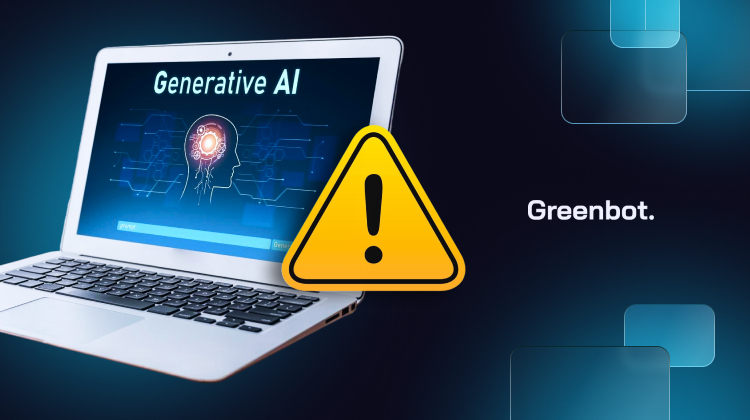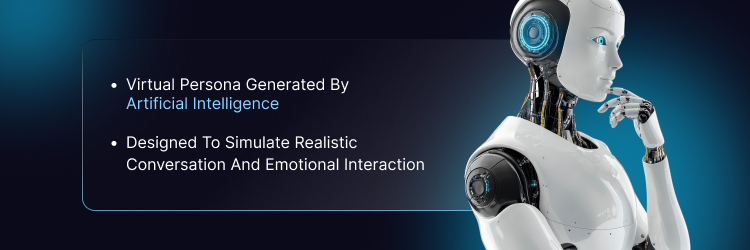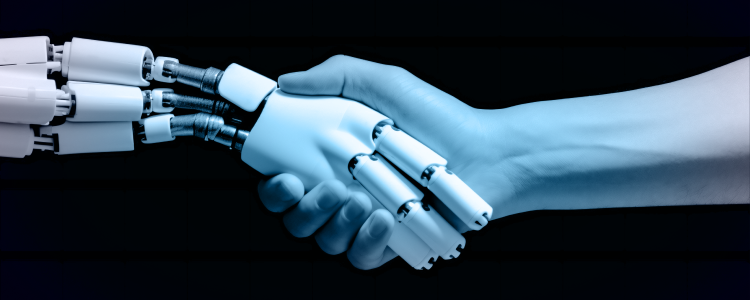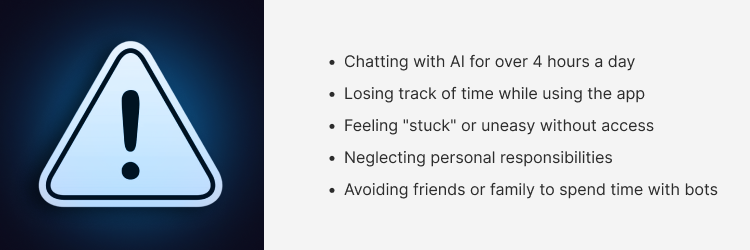
AI character addiction is becoming a growing concern. As more users turn to AI chats for emotional support, many find themselves developing strong attachments to AI characters. These connections can start out casually but may lead to disrupted routines, neglected relationships, and dependency.
In this article, we’ll cover what AI character addiction looks like, why it’s happening—especially among young people—and how you can take back control of your time and social life.
What Is an AI Character?

An AI character is a virtual persona generated by artificial intelligence, often designed to simulate realistic conversation and emotional interaction. These characters can be entirely fictional or modeled after existing personalities and are accessible through apps. Users can engage with them in role-playing, deep conversations, or even therapeutic-style dialogues.
The more you interact with these bots, the more they adapt to your tone, style, and emotional needs, making the experience feel increasingly human. For many users, this creates a sense of companionship and intimacy, which contributes to the growing appeal—and potential risks—of emotional dependency.
What Is Character AI Addiction?
AI character addiction refers to excessive engagement with AI chatbots like Character.AI, often driven by emotional dependence. Instead of occasional use, users may spend hours interacting with bots, leading to skipped meals, poor sleep, and limited offline interaction. The appeal lies in instant replies and emotionally affirming responses, which create a sense of connection and safety.
Over time, these interactions can go from casual to compulsive. The bots adapt to the user’s tone, style, and emotional cues, reinforcing a loop of digital validation that becomes difficult to break. As the emotional reward grows stronger, so does the likelihood of prolonged, repeated engagement.
Why Are So Many Young People Getting Addicted?
Young people often seek relief from loneliness, anxiety, or stress. AI chats can feel like a safe space—no judgment, always available, and easy to control. One user reported spending hours daily talking to a single bot, finding it easier than dealing with real conversations. These bots offer role-playing features and emotional validation, which can make it harder to let go.
Teenagers and young adults are especially vulnerable. Many are navigating identity, mental health, and social challenges. Character AI, for example, provides a sense of agency and intimacy that can feel more reliable than human relationships. This emotional security is exactly what makes the habit so sticky.
From Entertainment to Dependency: How It Escalates
What begins as casual chatting can slowly turn into emotional reliance. Here are some common signs:
- Spending a large portion of your free time with favorite characters
- Choosing AI chats over real conversations
- Feeling anxious when disconnected
- Losing interest in offline social activities
- Using AI as the first response to stress or boredom
This progression doesn’t happen overnight. It builds gradually, especially when users start using AI chats as a replacement for human connection.
Real-Life Costs of Character AI Addiction
The effects of addiction are often visible in everyday life:
- Strained relationships with friends and family
- Missed responsibilities at school or work
- Increased emotional instability or mood swings
- Disrupted sleep and daily routines
- Lower academic performance
Some users describe how their social life suffered because they spent more time talking to bots than to real people. Others found it hard to focus, finish tasks, or even maintain conversations offline. Emotional health may also decline when AI becomes a primary source of support, especially when it replaces authentic, reciprocal relationships.
Users who’ve quit using AI characters often report positive changes. One shared how quitting improved their sleep and helped them reconnect with friends. Another said they felt more present and capable of managing daily stress without relying on AI interactions.
This shift also raises bigger questions about the future of AI. As artificial intelligence becomes more emotionally responsive, its role in daily life continues to expand. How people relate to AI characters today could shape how society views companionship and digital intimacy in the years ahead.
The Loneliness Epidemic and the Rise of AI Chatbots

Loneliness has become more widespread since the pandemic, and AI platforms have stepped in to fill that emotional gap. AI chatbots are easy to access, available around the clock, and offer predictable validation. For people feeling disconnected, they provide a quick sense of comfort and companionship.
This isn’t just about one app. The rise of AI relationships is part of a larger shift in how people manage emotional needs. With more remote work, digital communication, and fewer in-person interactions, it’s become easier to rely on technology for connection. AI characters—from Character.AI to Replika and other platforms—are stepping in where social life once lived. The result is a growing dependence on digital comfort over human connection.
While these interactions might ease temporary discomfort, they can unintentionally reduce motivation to pursue or maintain real-world relationships. In the long term, the convenience of AI support may come at the cost of emotional resilience and interpersonal growth.
With fewer community ties, remote work, and less in-person interaction, people are more likely to turn to digital companionship.
Can AI Replace Real-World Relationships?
Q: Is chatting with AI the same as talking to a real person?
Not quite. AI responses may feel personalized, but they’re based on patterns, not real emotion.
Q: Can these bots offer true emotional connection?
They can simulate it, but many users feel a deeper disconnect after realizing the conversations lack mutual understanding.
Q: What happens when AI becomes your main social outlet?
Over time, users may lose touch with how to engage in real conversations or navigate complex emotions. This can lead to social withdrawal and decreased confidence in real-life settings.
How Addiction Impacts Your Mental Health
Extended AI use can affect emotional well-being in several ways:
- Lower self-confidence
- Heightened anxiety or irritability
- A sense of emotional isolation
- Escaping real-life discomfort instead of processing it
When AI becomes a coping tool, it can delay the urge to seek professional or personal support. This avoidance can reinforce a cycle of isolation, where real emotions are never properly addressed.
First Signs You Might Be Addicted

Here are a few signs to watch for:
- Chatting with AI for over 4 hours a day
- Losing track of time while using the app
- Feeling “stuck” or uneasy without access
- Neglecting personal responsibilities
- Avoiding friends or family to spend time with bots
If these sound familiar, you may benefit from setting boundaries.
Why It’s Hard to Quit AI Characters
AI characters are built to feel responsive and relatable. Validation, comfort, and immersive conversations can make them feel like close friends. That emotional connection can make it difficult to take a break, even when users know it’s needed.
Role-playing options and deeply personalized conversations can also create a sense of emotional intimacy. These bots learn from your behavior and mirror it back, reinforcing a pattern of emotional reward that feels authentic, even though it’s algorithmic.
Healthy Coping Mechanisms to Replace AI Chats
Instead of relying on AI, try:
- Talking to a friend or family member
- Keeping a journal or speaking to a therapist
- Spending time on offline activities like reading, walking, or creative hobbies
- Volunteering or joining a community group
- Practicing mindfulness or daily gratitude
These habits can fill the same emotional gaps without the long-term downsides.
How to Set Boundaries With AI Apps
To reduce dependency without cutting off completely:
- Limit daily usage with timers or app controls
- Turn off app notifications
- Designate screen-free hours or weekends
- Use the app only during specific times (e.g., after work)
- Uninstall the app temporarily if needed
These small changes help create a healthier relationship with technology.
Getting Professional Help
If reducing AI use feels overwhelming, a therapist can help you understand the patterns behind your attachment. Professional support can also guide you in building new strategies for emotional regulation and connection.
Therapy offers tools to explore why AI feels emotionally safe, and how to transfer that need into healthier, more reciprocal relationships.
Can You Go Back to Casual Use After Quitting?
|
Pros |
Cons |
| Regain structure and flexibility | Risk of returning to excessive use |
| Reconnect with real people | Emotional triggers may reappear |
| Use AI for fun, not support | May undo progress made during break |
Some users return to light use after a break. Others find it easier to avoid AI altogether. What matters is identifying what works best for your needs and emotional health.
FAQs About Character AI Addiction
What is character AI addiction?
It refers to excessive use of AI chats for emotional comfort, often leading to neglect of real-world relationships.
How do I know if I’m addicted to AI chats?
You may notice yourself skipping meals, losing time, or avoiding social interaction in favor of chatting with AI.
Can character AI replace real human relationships?
No. AI can simulate conversation, but it doesn’t replace mutual care, unpredictability, or growth in real relationships.
How long does it take to break AI dependency?
It varies. Some users regain balance within weeks, while others take months or more than a year to fully disconnect.
Is using AI chat always a bad thing?
Not necessarily. Casual, intentional use can be harmless. The issue arises when usage starts to interfere with real-world obligations and relationships.























